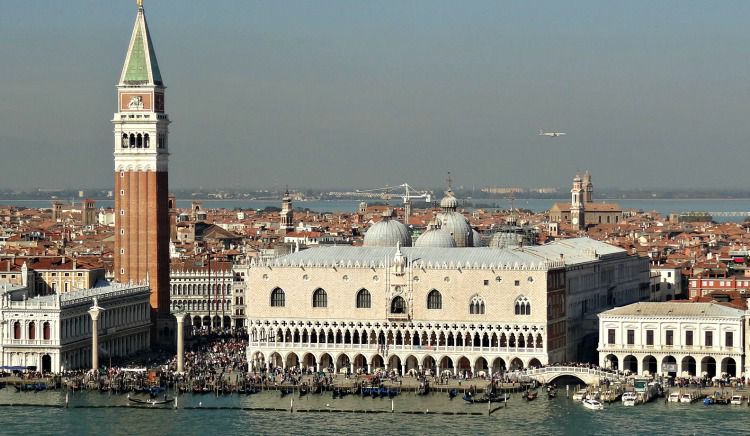
Doge’s Palace – a Venetial Republic Governmental Building made in centuries
Doge’s Palace: A Monument of Venice Republic
In Middle Ages and Renaissance Venice was an independent republic with its government structure and assets. The seat of the Venice government before 810 was the island of Malamocco, which after that date moved to the present-day Rialto, according to an order by Agnello Participazio, the tenth traditional Doge of Duchy of Venetia. The current Doge’s Palace place matches with that order, but nothing has remained from its former buildings, and several developments remained from the 10th to 13th century.


Following a series of political challenges in Europe in the 13th century and a considerable increase in the number of the Great Council’s members, the necessity of rebuilding the palace was felt, which led to the construction of the first buildings of the new Gothic palace that we know today in 1340. Like most other medieval palaces and castles, it is developed and constructed in several phases in various historical periods to cover the required functions. In the following article, we will track various phases of Doge’s Palace development to its current structure.
Doge’s Palace in 14th century
The current building construction started in 1340 under Doge Bartolomeo Gradenigo to provide enough place for Great Council members. This first palace designed to face the Venetian lagoon and included a small part of the current palace.
The other important change in the palace’s décor and architecture took place in 1365 when the artist Guarientoreceived an order to decorate the east wall of the Great Council Chamber with a large fresco. At the same time, the decoration of the windows of rooms also changed. While the main and primary reason for building Doge’s Palace was making room for the Great Council, its meetings were not hosted in this chamber until 1419.

Doge’s Palace Renovations in 15th century
The building and structure of this palace remained intact for almost a century, as new phases of its development started in 1424 by Doge Francesco Foscari (1423-1457). This development took place as a continuation of its previous relationship with the lagon, in which a ground-floor arcade was made on the outside, and open first-floor balconies were added to the palace as well as an internal courtyard side of the wing.
In this phase of the palace’s development, a large library was added to the floor of the Great Council Chamber, and the same previous Gothic materials were also used for its decoration.Construction of the Porta Della Carta by Giovanni and Bartolomeo Bon completed the Piazzeta’s façade.
In the late 15th century, some developments of other wings of the palace took place by the construction of the Foscarientrance beyond the Porta Della Carta and building of FoscariArch. However, these developments were completed when Giovanni Mocenigo (1478-1485) was the Doge.

The Other Wings of Doge’s Palace: 16th-century developments
Various phases of the palace’s development in the 16th century were reactions to several fires that damaged the palace. The first fire happened in 1483 and destroyed the canal-side of the palace, in which the Doge’s Apartments were placed. Antonio Rizzo was commissioned for its reconstruction who introduced elements of the new Renaissance architecture to the palace.
Rizzo started a completely new structure alongside the canal and included many parts and works, which only were completed in 1510 when Rizzo was replaced by MasteroPietro Lombardo who changed the decoration of the fecadeand Giant’s Staircase that is placed in the internal courtyard.However, Lombardo was replaced by Antonio Abbondi, who finally completed the works in 1559. This phase of rebuilding Doge’s Palace ended with the erection of two large marble statues of Mars and Neptune in 1565, which were created by Sansovino.
However, in 1574, some of the second-floor rooms were destroyed by another fire. That accident caused a change of decoration materials from wood to other fire-resistant materials. When these rebuildings had been done in 1577, another fire burned Salla Dello Scrutinio and Great Council Chamber that destroyed many masterpieces that were placed in the palace. Reconstruction started rapidly to restore the palace to its original form that completed in 1580.

Doge’s Palace’s Prisons: 17th-century developments
Various rooms and places that were incorporated in the palace had use cases more than the seat of the government and Doge’s apartments, and also included prisons. Antonio da Ponte who was Doge in the 16th century ordered the construction of new prisons, which were built by Antonio Contin around 1600, and linked to the Doge’s Palace by the Bridge of Sighs.
Since this development transferred prisons from the ground floor of the palace to another area, it made these rooms free, which caused further developments in the 17th century.Several structures made from marble were also added to the palace in 17th-century developments.
The fall of the Venetian Republic
In 1797 the Venetian Republic fell, and the role of Doge’s Palace as its main governmental building was inevitably changed. In the following century, Venice was subjected to the rule of several countries such as France, Austria, and finally, in 1866, it joined a united Italy. The palace in all these transfers was used by various administrative offices.

In the late 19th century, the necessity of extensive restoration felt and the Italian government appropriated large funds for this process. Finally, in 1923, the owner of the palace, namely the Italian State, changed its function to a public museum and appointed the City Council for its management.
Closing Thoughts
Doge’s Palace is a beautiful building located in Venice and is one of its most important landmarks. This palace was originally made to house the Great Council meetings that regarding an increase in its members required a larger place.Its building was started in the 14th century and its development continued until the fall of the Venetian Republic in the 18th century.
In these centuries several functions and uses were added to this Venetian palace such as apartments, libraries, Great Council Chamber, courtyard, second-floor open balconies, the Giant’s Staircase, and prisons. Today, it is a public museum that is open to various visitors from different countries who want to experience a great masterpiece of Gothic architecture with elements of Renaissance.












